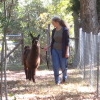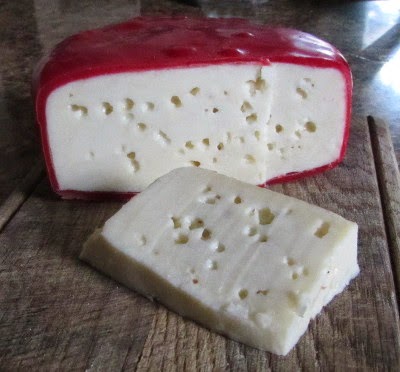| Online: | |
| Visits: | |
| Stories: |

| Story Views | |
| Now: | |
| Last Hour: | |
| Last 24 Hours: | |
| Total: | |
15b0513
 |
| Cheese 15b0513 |
I have not blogged about cheese making in a long time. This is mostly because I didn't make any hard cheeses this past summer, I focused mostly on mozzarella. The reasons for that was 1) we had all twins and triplets which meant more milk going to kids, and 2) of my 19 previous cheeses, only a couple had been okay. I was considering giving up on hard cheeses.
The other day I looked in the fridge and saw two cheeses left. I grabbed one thinking it would probably be another flop, but suitable for the pigs. I was surprised at how pretty it looked when I cut it open. I took a cautious taste. It was sharp, having aged for about a year and a half, but it was pretty good! I made myself a grilled cheese sandwich and was pleasantly surprised. This cheese was very good.
Labeled 15b0513, it was a second try at one of my repeatable cheeses – No. 15. It's a washed curd cheese using aged mozzarella whey for the culture (I don't buy cheese cultures). Washing the curd means that instead of “cooking” the curd in it's own whey, the whey is drained and the curds are “cooked” in warm water. The result is a milder cheese. Rather than give you the entire recipe in this post, click here if you're interested in that.
The thing that seems somewhat providential in this tale, is that the very next day I went to buy hay. I hadn't purchased hay from this source before, a dairy farmer about an hour's drive away. They grow and cut their own hay, this one being triticale cut in the milk stage. That means that it was cut before the grains had ripened, so that the critters get the entire plant – leaves, stems, and immature grain heads – very nutritious. Anyway, when he found out I had goats the gentleman asked me if I made cheese. I hesitantly said yes. He said he had hay available all year and if I was willing, he would love to trade cheese for hay. (!!!!)
Oh, the “15b0513″? It's just a code I made up to keep track of which cheese is which. 15 is the original cheese number, b means it's my second try, and 0513 refers to the date I made it, May 2013.
I can only add that my cheese journal, with detailed notes about all my hard cheese experiments, is invaluable. I even notated which goat's milk I used. I think that's significant because my year of cheese making included Jasmine's milk. For those who don't know or may not remember, Jasmine was a Nubian of mine with a lot of health issues. Her milk tasted fine, but why should I be surprised that the cheese from it wasn't the best? If what they eat can effect the taste of the cheese, why wouldn't subclinical health problems?
Now I'm excited about making cheese with my Kinder milk. First kid(s) due in mid-March. Second kidding will be early April. There's nothing finer than new kids, fresh milk, … and cheese!
Source: http://www.5acresandadream.com/2015/02/15b0513.html



